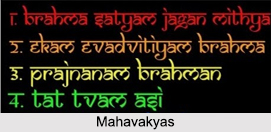 Mahavakyas are the "Great Sayings" of the Upanishads and the foundational texts of Vedanta. The Mahavakyas emerged to condense the meaning of the majestic Vedas. Mahavakyas are the great sentences of Advaita Vedanta and Jnana Yoga that are mentioned in the Upanishads. The word "Maha" is Great and "Vakyas" are sentences, or utterances for meditation. They provide perception and insights that combine the texts together in a consistent whole. The contemplations on the Mahavakyas also merge well with the practices of yoga meditation, prayer and mantra, which are associated practices in Yoga.
Mahavakyas are the "Great Sayings" of the Upanishads and the foundational texts of Vedanta. The Mahavakyas emerged to condense the meaning of the majestic Vedas. Mahavakyas are the great sentences of Advaita Vedanta and Jnana Yoga that are mentioned in the Upanishads. The word "Maha" is Great and "Vakyas" are sentences, or utterances for meditation. They provide perception and insights that combine the texts together in a consistent whole. The contemplations on the Mahavakyas also merge well with the practices of yoga meditation, prayer and mantra, which are associated practices in Yoga.
Four Mahavakyas of Upanishads
Each of the Mahavakyas is related with one of the four Vedas and in Vedantic mysticism. The Mahavakyas provides the essence of entire Veda in one statement. All four Mahavakyas indicate the ultimate unity of the individual (Atman) with God (Brahman).
The Mahavakyas of the Upanishads are as follows:
1. Ayam Atma Brahma - "This Self (Atman) is Brahman" (Mandukya Upanishad 1.2 of the Atharva Veda)
2. Prajnanam Brahma - "Consciousness is Brahman" (Aitareya Upanishad 3.3 of the Rig Veda)
3. Aham Brahmasmi - "I am Brahman" (Brhadaranyaka Upanishad 1.4.10 of the Yajur Veda)
4. Tat Tvam Asi - "Thou art That" (Chandogya Upanishad 6.8.7 of the Sama Veda)
The Mahavakyas make the wisdom more accessible. Seven Mahavakyas are followed generally and by focusing on these the rest of the principles of self-exploration described in Vedanta and the Upanishads are more easily understood.
Significance of Mahavakyas
To understand the meaning of the Mahavakyas, it is necessary to practice meditation. Mahavakyas are not practiced as blind faith beliefs, but rather are reflected on by many experts so that their meaning is validated in direct experience. Some methods of Sadhana give the Sadhaka a principle, a word, on which he usually reflects, but if he concentrates on Mahavakyas, the effectiveness is much faster. In contemplating the Mahavakyas, it is not a matter of merely accepting that the statements are true.
The passionately dedicated practitioner will contemplate on one or more of the Mahavakyas repeatedly over a long period of time. Mind gradually comes to have a superior understanding, and then the mind becomes still as the meditation shifts from an observing, reflective process into a deep contemplative meditation. Reflection transforms into insight, which again transforms into the direct practice of the essential truth or reality of the Mahavakya.
Mahavakyas are still some of the core statements used by hermits and sages to train their disciples throughout India. The Mahavakyas have become more of proverbs in Indian Literature than texts of scriptures.




















